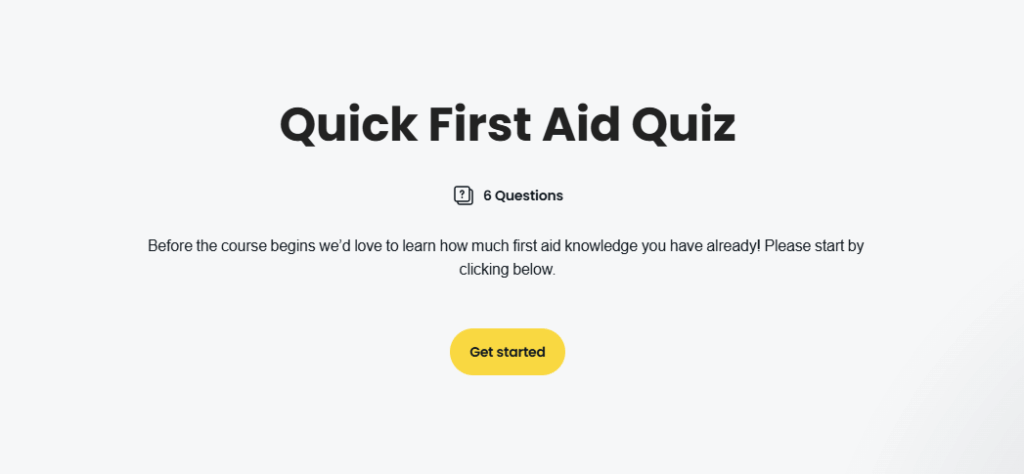The right training icebreakers can transform an awkward training sessions into one that flows, and gets learners comfortable among one another, and working together.
Whether you’re working with small groups or large training seminars, using a simple icebreaker is a fun way to build relationships, boost energy levels, and get conversation flowing.
We’ve grouped the best icebreakers into categories so you can quickly find the right activity to match your training topic, group size, and delivery format (in-person or virtual).
Name & Introduction Icebreakers
These are perfect for kicking off new training groups, and help participants learn each other’s names while building a relaxed atmosphere.
1. Name Game (with an Object)
This icebreaker involves each participant introducing themselves and names an object that starts with the same letter as their first name (e.g. ‘I’m Sam and I brought a Sandwich’).
It’s a great icebreaker that helps people remember names in a fun way.
2. Self Portrait Swap
This is a great one to get creativity flowing!
Give everyone one minute to draw a quick self portrait. Then shuffle and redistribute the portraits. Each person must then guess whose drawing they received.
Its a guaranteed way to get people talking and laughing!
3. Trading Card Icebreaker
Similar to the self portrait swap, ask participants to create a “training card swap” with their own name, and one fun fact. Then, have them swap with other members.
It’s a quick way to build rapport and encourage fun early in the session.

Quick Icebreakers to Boost Energy
Icebreakers to boost energy should be used when you notice energy levels dipping, or to get participants moving between modules.
4. Stand in a Circle – Two Lines Game
In this classic icebreaker, participants form two lines facing each other. The facilitator asks as question, such as “What’s your go-to productivity tip?” or “What’s an interesting fact about your industry?”.
Each pair takes a moment to answer the question, after which one line rotates, creating new pairings for the next round
This activity works really well at keeping the conversation flowing, and to introduce a fun element of friendly competition. It also encourages participants to engage with a wider range of group members in a short time frame.
5. Same Shoe Size Shuffle
To begin this icebreaker, ask participants to silently find someone in the room who shares their shoe size.
No verbal communication is allowed during the search, which encourages participants to use observation and non-verbal cues. Once a match is found, participants introduce themselves to one another, and share an interesting fact about their work.
Its a quick, easy, simple ice breaker that build relationships early in a session, particularly in sessions where participants are initially hesitant to speak up.
6. Magic Box Pick
Prepare a box filled with slips of paper, each containing a different question or creative prompt. Examples might include “What’s one skill you’ve mastered in your career?” or “Who is a famous person you admire and why?”.
One participant then draws a slip, reads the question aloud, and answers it before passing the box to the next person. Its a fun activity that encourages quick thinking, active listening and helps participants open up in a relaxed setting.

Icebreakers That Involve Movement
7. Puzzle Connections
Give each participant a puzzle piece labeled with a term or concept related to the training topic. Each participant’s task is to find the person whose piece fits logically with theirs, for example, “Course Design” might pair with “Instructional Objectives”.
It works well at encouraging problem solving and gets participants talking about course content from the start.
8. Training Wins Chain
Each participant takes a moment to share a small success or positive outcome they’ve experienced as a result of a previous training they’ve taken.
This could be a new skill they applied, a process they improved, or a moment where their learning made a difference in their work.
The next participant then shares their own example, ideally linking it to a similar theme. It helps create a positive atmosphere, and encourages group members to reflect on the real-world value of training.

9. Index Fingers Balance
This works great if you’re delivering training to small groups. You get all of them to balance a lightweight stick or rod using only their index fingers. The goal is to lower it to the ground together.
Its tougher than it sounds! But excellent for team building events that help build communication and coordination.
Icebreakers That Spark Creativity
10. One Word Story Chain
Participants sit in a circle and build a story together by contributing one word at a time. The story should relate to the training topic, but you can leave room for the story to evolve creatively.
It lightens the mood, gets everyone talking, while also keeping them engaged and alert.
11. Movie Pitch Icebreaker
In small groups, participants create and pitch a fictional movie inspired by the training subject. They must develop a title, a basic plot, and choose a famous person to start in the lead role.
Its a great way to turn an abstract idea into a fun, tangible idea while encouraging storytelling and group creativity.
12. Creative Name Association
Each participant introduces themselves with a playful comparison, such as “If I were a training tool, I’d be a whiteboard because I help make things clear.”
Encourage participants to get creative the more creative the answer, the more laughter and more memorable introduction.
Icebreakers for Deeper Engagement
13. Truths and a Lie
Ask each participant to share three statements about themselves, two that are true and once that’s a lie. The rest of the group must guess which one isn’t real.
Its a classic icebreaker that works well in training sessions because it prompts active listening, and encourages participants to reveal something personal in a light, low pressure format.
14. Rose, Bud, Thorn
Each participant shares one “Rose” (something positive they bring to or hope to get from the training), one “Bud” (a growth opportunity or new idea they’re exploring, and one “Thorn” (a challenge they’re facing.
The Rose, Bud, Thorn technique helps frame the training session in a personal way, encourages reflection, and sets the tone for honest discussion.
Icebreakers for Online or Virtual Training Sessions
15. Quick Quiz Poll
Inject energy into your session with a short, live quiz that reinforces key concepts and sparks friendly competition. You can use tools like Slido, or Zoom pools to ask 3-5 multiple choice or true/false questions based on recent content.
It’s a chance to surface misunderstandings, and re-engage participants.
Best practices for quick polls include making sure you keep questions short and clear, make sure you align questions with key takeaways, and you can even add a little friendly challenge, such as acknowledging top scores, or announcing quiz winners at the end of a session.

16. Show & Tell
Just like we used to do at school, bringing in something and talking to our peers about it is a great way of connecting and getting to know one another. In a training setting you can facilitate this ice breaker by asking participants to bring something from their day to day work that connects with the training topic.
It could be a tool, a real-world challenge, or an example of a best practice. Give each person a minute to explain what they’ve brought and why it matters. Its a great icebreaker that works particularly well in technical or workplace profession training, where peer to peer knowledge is key.
If you’re running online training, encourage screen sharing or pre-uploaded images.
17. Speed Networking Breakout Rooms
Use timed breakout rotations to help participants build quick connections and warm up their communication skills.
You can pair them up, or put them into small groups and give them a structured prompt (e.g. “Share a challenge you face related to day’s topic”), or “What’s one thing you hope to learn today?”).
After 2-3 minutes, rotate and repeat.
Tips for Using Training Icebreakers Effectively
Training icebreakers are most effective when they are planned out, and align with your session goals. Use the tips below to make sure your icebreaker game supports rapport building, and sets the tone for a meaningful training session 👇
1. Match the icebreaker game to the meeting topic
Choose an activity that supports your set learning goals. For example, if you were running a session on communication skills select an icebreaker that encourages dialogues and discussion.
2. Set up clear instructions
Before starting, explain the icebreakers purpose, the time frame, and what participants should. For example, you can check all participants understand, or provide examples to help get them started.
3. Involve everyone, from first person to last
Be intentional about making sure everyone is involved. If its a small group this may be easier, if its a larger group consider breaking participants into smaller groups,.
4. Use clear criteria to guide responses
If you’re asking participants questions where they need to respond, make sure you set clear criteria for a response. For example, if you’re looking to find out what skills participants want to work on, you can clerly ask them “What’s one skill you’re hoping to improve during this session”, during an icebreaker.
5. Make it more than a warm up
Yes, of course the aim of an icebreaker is to get participants warmed up and engaged, but you should treat it as a creative activity that leads into your main content.
Use the icebreaker as an opportunity to spark discussion, uncover assumptions, and introduce the training topic in a way that’s fun, interactive, and low pressure.
Final Thoughts
There you have it! 17 fun training icebreakers you can use to set the tone, build early rapport, and make participants feel comfortable contributing.
They work well no matter what kind of training your are running, and can be adapted to suit the size, topic, and needs of your participants.
If you can remember to choose activities that align with your topic, group size, and delivery format, you can make the opening moments of every training session count!
Looking for a platform to help you create, delievr and manage training?
Try Arlo Training Management Software for free. Get started with a 14-day trial.